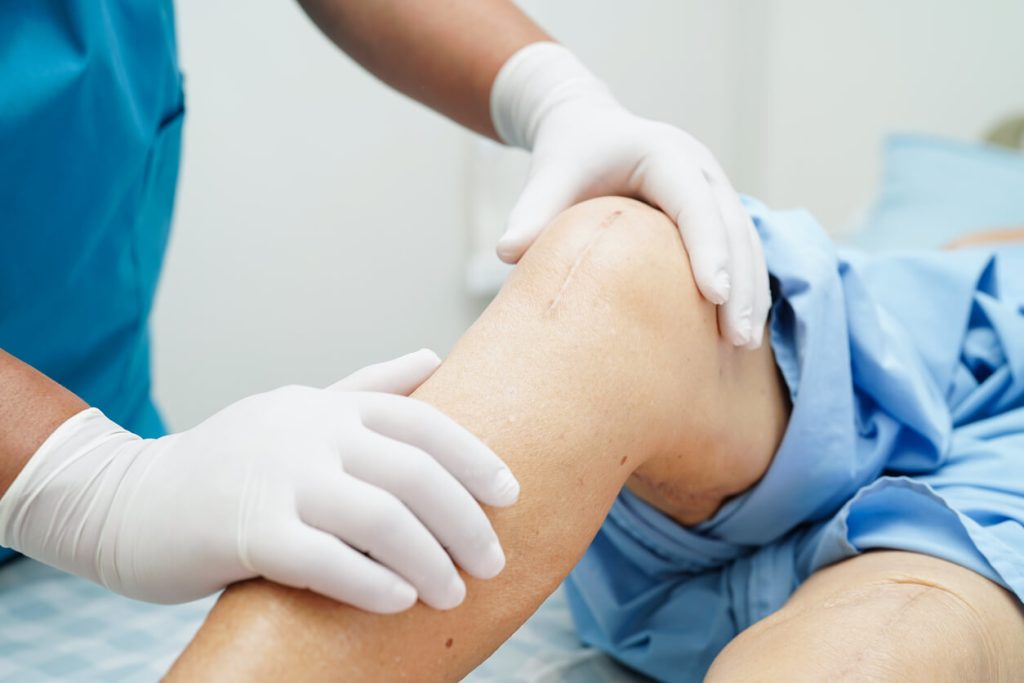Knee Replacement Surgery in Gorakhpur
Best Knee Replacement Doctor in Gorakhpur – Dr. Vatsal Khetan
Are you suffering from chronic knee pain, arthritis, or limited mobility? It might be the right time to consult the best knee replacement doctor in Gorakhpur — Dr. Vatsal Khetan, renowned for his skill, compassion, and patient-first approach. With years of experience in total knee replacement in Gorakhpur, he has helped numerous patients walk pain-free and regain their active lives.
What is Knee Replacement Surgery?
Knee replacement surgery in Gorakhpur is a highly effective procedure that replaces the damaged or worn-out knee joint with artificial implants. It helps reduce pain and improve function in patients suffering from:
Osteoarthritis
Rheumatoid Arthritis
Knee fractures
Knee arthritis treatment in Gorakhpur
Depending on your condition, Dr. Vatsal may recommend total knee replacement surgery , mini knee replacement surgery, or MIS knee replacement in Gorakhpur for a quicker recovery.

Why Choose Dr. Vatsal Khetan – Knee Replacement Surgeon in Gorakhpur?

Specialized Training
Dr. Vatsal Khetan is an experienced knee replacement surgeon in Gorakhpur, specializing in MIS knee replacement and total knee replacement techniques.

Patient-Centric Approach
Each patient receives a personalized treatment plan with a focus on comfort, fast recovery, and long-term success.

Advanced Surgical Techniques
Dr. Khetan uses modern technology and minimally invasive methods for optimal results and faster healing.

Trusted Knee Replacement Specialist
Patients consider him one of the best knee replacement doctors in Gorakhpur, known for delivering safe and effective surgeries.
Types of Knee Replacement Surgeries We Offer
Knee Infection Treatment in Gorakhpur
Infections post-surgery can be serious. We provide specialized knee infection treatment in Gorakhpur to manage complications and support full recovery.
Post-Knee Surgery Recovery Tips
After your knee replacement surgery in Gorakhpur, follow these tips for best results:
FAQ
When should I consider Knee Replacement Surgery in Gorakhpur?
If knee pain affects your daily routine like walking, standing, climbing stairs, or sleeping at night — even after medicines, physiotherapy, or injections — you may need Knee Replacement Surgery. Consulting an expert like Dr. Vatsal Khetan, Best Knee Replacement Doctor in Gorakhpur, ensures timely treatment and prevents worsening of arthritis.
How long does recovery take after Knee Replacement Surgery?
Most patients stand and walk within 24 hours under guidance. Complete recovery usually takes 6–12 weeks, depending on age, overall health, and physiotherapy. With modern MIS techniques, Dr. Khetan ensures faster healing, less pain, and quicker return to normal life.
What are the benefits of MIS (Minimally Invasive) Knee Replacement in Gorakhpur?
MIS Knee Replacement involves smaller cuts, less blood loss, reduced pain, and fast rehabilitation. Patients walk sooner and have minimal scarring. This advanced technique is one of the major reasons why many patients prefer Dr. Khetan for Knee Replacement in Gorakhpur.
How long do knee implants last after surgery?
The latest knee implants used by Dr. Vatsal Khetan are highly durable and can last 15–20 years or more with proper care. High-quality implants ensure long-term comfort, stability, and mobility — giving patients a more active and independent life.
Is Knee Replacement safe for senior citizens in Gorakhpur?
Yes. With advanced anesthesia and optimized surgical techniques, knee replacement is considered very safe, even for older patients. Pre-surgery evaluation ensures the heart, lungs, and overall health are ready — making surgery safe and successful for senior citizens.
Where can I get affordable Knee Replacement Surgery in Gorakhpur?
The cost of Knee Replacement varies based on implant type and medical needs. Dr. Vatsal Khetan provides high-quality, affordable knee replacement treatment with advanced implants and best-in-class care — ensuring optimal results for patients in Gorakhpur and nearby areas.

Meet the Best Knee Replacement Surgeons in Gorakhpur
Led by Dr. Vatsal Khetan, our orthopedic team includes some of the most experienced knee replacement surgeons in Gorakhpur. Whether you're considering total knee replacement surgery, mini knee replacement, or knee arthritis treatment, we ensure safe procedures, faster recovery, and long-term success.
Searching for the best knee replacement in Gorakhpur? Or a trusted expert for knee replacement surgery in Gorakhpur? Look no further than Dr. Vatsal Khetan, your go-to knee replacement doctor in Gorakhpur.
Benefits of Total Knee Replacement by Dr. Vatsal Khetan – Leading Orthopedic Surgeon in Gorakhpur
If you’re suffering from chronic knee pain or mobility issues, Total Knee Replacement (TKR) can offer a new lease on life. Under the expert care of Dr. Vatsal Khetan, one of the most trusted orthopedic surgeons in Gorakhpur, patients can expect a safe, effective, and transformative surgical experience.
Key Benefits of Total Knee Replacement in Gorakhpur:
1. Long-Term Pain Relief
The biggest advantage of TKR is substantial pain reduction. Patients no longer have to struggle with day-to-day discomfort, stiffness, or pain caused by arthritis or injury.
2. Improved Mobility and Flexibility
Following a successful knee replacement surgery, patients typically experience improved joint movement, allowing them to walk, climb stairs, and enjoy light physical activities with ease.
3. Better Quality of Life
Say goodbye to limitations! With improved functionality and less pain, patients enjoy greater independence and a more active, fulfilling lifestyle.
4. Durable and Long-Lasting Implants
Dr. Vatsal Khetan uses advanced prosthetic implants designed to last for 15-20 years or more, ensuring lasting results and peace of mind.
5. Personalized Treatment Plans
Every patient is unique. Dr. Vatsal Khetan focuses on tailored treatment and post-surgical care for optimal recovery and long-term success.
